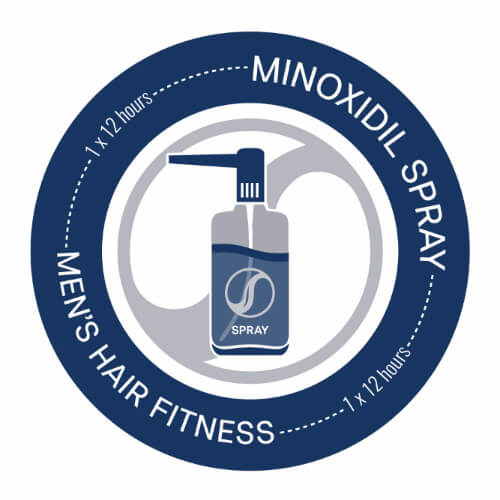Genetics and DHT drive male hereditary hair loss
The dreaded duo of hair loss
Whether or not you experience male pattern hair loss is down to a combination of you genetics1 and a male hormone called dihydrotestosterone (DHT). Genetics determines if and when receptors in the hair follicles become sensitive to DHT. The amount of DHT interacting with your hair follicles, in combination with how sensitive your genetics make the receptors, determines how quickly your hair thins. The good news is there are FDA approved treatments which can limit the damage DHT does to you hair.
DHT is responsible for several different activities in your body
The hormone is created in various locations in the male body, including hair follicles through the action of molecules called 5α-reductases on the grandaddy of all male hormones, testosterone. During puberty DHT drives the development of what are known as secondary sexual characteristic in males, these include facial hair and an adam's apple. The problems begin if your genetics are programmed to 'flip a switch' which will make receptors in your hair follicles sensitive to DHT in a manner which leads to hair loss. The younger you are, the more testosterone there is in your system; this explains why the earlier the receptors switch on the more aggressive your hair loss2.
Your hair thins as its growth cycle is disrupted
Each individual hair has four distinct phases to its life cycle3. Once the genetic switch flips, DHT will cause your hair follicles to shorten their Anagen growth phase and move prematurely into the Telegoen resting phase. In a healthy scalp, around 90% of the hair follicles are in their Anagen phase and 10% in the Telegoen phase at any one time. However, once thinning commences, up to 30% of a man’s hair follicles will be in Teleogen phase as Anagen is curtailed.
Over time, the presence of DHT will cause the hair follicle to become increasingly smaller and the hair that it grows will become progressively finer and lose its pigmentation. Eventually, the hair follicle stops producing even the final fine vellus hairs and is lost. The length of this cycle is driven by the amount of testosterone, and therefore DHT, in your system. For a man in his late 20’s or early 30’s, once hair loss commences the follicles can be lost in a few years, whereas a man in his 50’s may take decades to reach the same degree of thinning.
Managing your hair-loss by going after DHT
The two most effective, medically-proven treatments4, Minoxidil and Finasteride go after DHT but in subtly different ways. Minoxidil in a topical (applied directly to the scalp) treatment neutralises the effects of DHT on your hair follicles directly5. This explains why it has the most immediate effect, often within 3 months of the commencement of treatment.
Finasteride works by inhibiting two of the three different forms of 5α-reductase so that the DHT is not created in the first place. By reducing the production of DHT (by as much as 71%6 as seen in sstudies), it produces a long-term effect which is usually noticed after 6 months of continuous use. This effectiveness has to be balanced with the potential side-effects, around of 3% of men experience problems when using it7.
The good news is that these two treatments, when used consistently, can hit hair loss with a one-two punch to help you keep your hair fit and healthy8.
Your genetics set the scene but how it plays out is up to you
Your genetics determines when and how sensitive your hair follicles will be to DHT. The level of DHT in your system will then determine how rapid your hair-loss will be. You can’t change your genes but there are clinically proven safe and effective ways to manage the amount of DHT in and on your scalp. The FDA approved pharmaceuticals Minoxidil and Finasteride use two different mechanisms to reduce the impact of DHT, making them effective treatments on their own, and a potent combination together. The team at Hair Fitness are developing a range of safe cost-effective treatment plans based on these two active ingredients to help you keep you keep on top of your hair. If you want to be kept informed please subscribe to our blog.
- See our blog post on the genetics of hair loss for background.
- See
- See our blog post on the hair growth cycle for more information.
- Minoxidil and Finasteride are approved by the FDA, the TGA and Medsafe for the treatment of male androgenic alopecia (Male pattern hair loss).
- McConnell JD, Wilson JD, George FW, Geller J, Pappas F, Stoner E (March 1992). “Finasteride, an inhibitor of 5 alpha-reductase, suppresses prostatic dihydrotestosterone in men with benign prostatic hyperplasia”. J. Clin. Endocrinol. Metab. 74 (3): 505–8.
- There is another clinically proven pharmaceutical treatment, Dutasteride, which does an even better job by blocking the action of all three types of 5α-reductase and reducing the DHT in your body by up to 94% (see Clark RV, Hermann DJ, Cunningham GR, Wilson TH, Morrill BB, Hobbs S (May 2004). “Marked suppression of dihydrotestosterone in men with benign prostatic hyperplasia by dutasteride, a dual 5alpha-reductase inhibitor”. J. Clin. Endocrinol. Metab. 89 (5): 2179–84.) however, the side effects are more frequent than finasteride so it is not widely used for the treatment of male pattern hair loss (see http://urologytimes.modernmedicine.com/urology-times/news/clinical/clinical-pharmacology/finasteride-had-fewer-sexual-side-effects-compared).
- See our blog post on Finasteride for an in depth discussion.
- Finasteride and minoxidal serious medications (as opposed to herbs and hokus pokus) and as such should only be used under appropriate medical supervision.
Also in Research & News

Saw Palmetto - a natural way to reduce DHT
An alternative for Men who want to explore a more natural way of blocking DHT is Saw Palmetto. Widely used in the treatment of enlarged prostates, a condition closely hormonally linked to hair loss, there is good scientific evidence that it significantly reduces free DHT and thus protects your hair.
Learn how Saw Palmetto acts to reduce thinning by disrupting the production of DHT. This can have a powerful impact on its own or it can be used to enhance the effect of other treatments as part of a combined program.

What to expect from minoxidil treatment
In the short-term Minoxidil will halt further loss in 95% of men after 3 months of a twice-daily routine. Over a few months, 60% of men will report significant regrowth, especially for those that act quickly to stop the loss. After a year of continuous use, you should expect the initial gains to stabilize as you hair bounces back and you get the thinning under control.The key to using minoxidil is to get into and stick with a healthy routine to get on top of your hair and maintain your gains.

How to sell snake oil
The value of the global hair-loss treatment market is a $2.7bn USD in 2017, which is not surprising when you consider how widespread male pattern hair loss is. Unfortunately, a market that largely attracts not only serious research and clinically proven products, but also a host of more dubious “treatments” and, in some cases, completely unscrupulous “cures”. These can range from the seemingly well-intended but ineffective treatments to outright frauds.
